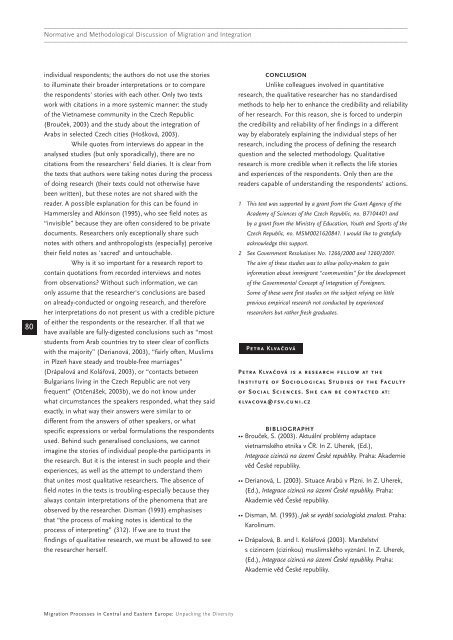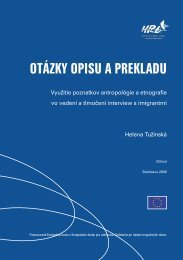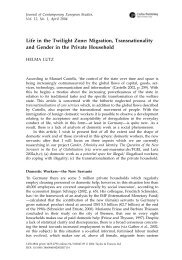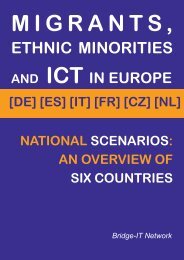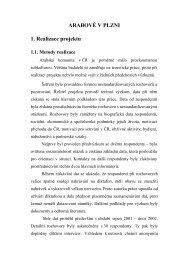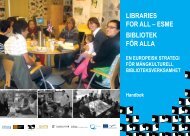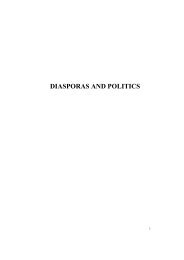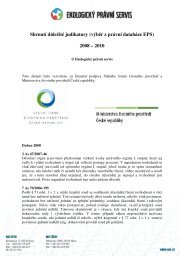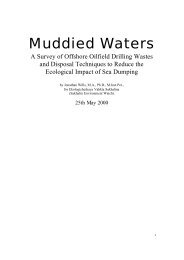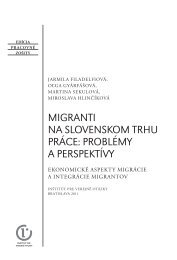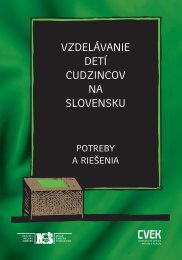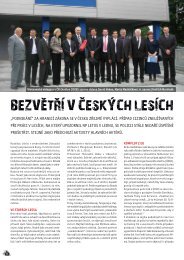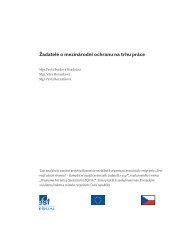Migration Processes in Central and Eastern Europe - Multiple Choices
Migration Processes in Central and Eastern Europe - Multiple Choices
Migration Processes in Central and Eastern Europe - Multiple Choices
Create successful ePaper yourself
Turn your PDF publications into a flip-book with our unique Google optimized e-Paper software.
———————————————————————————————————————————————————————————————<br />
Normative <strong>and</strong> Methodological Discussion of <strong>Migration</strong> <strong>and</strong> Integration<br />
———————————————————————————————————————————————————————————————<br />
80<br />
<strong>in</strong>dividual respondents; the authors do not use the stories<br />
to illum<strong>in</strong>ate their broader <strong>in</strong>terpretations or to compare<br />
the respondents' stories with each other. Only two texts<br />
work with citations <strong>in</strong> a more systemic manner: the study<br />
of the Vietnamese community <strong>in</strong> the Czech Republic<br />
(Brouček, 2003) <strong>and</strong> the study about the <strong>in</strong>tegration of<br />
Arabs <strong>in</strong> selected Czech cities (Hošková, 2003).<br />
While quotes from <strong>in</strong>terviews do appear <strong>in</strong> the<br />
analysed studies (but only sporadically), there are no<br />
citations from the researchers' field diaries. It is clear from<br />
the texts that authors were tak<strong>in</strong>g notes dur<strong>in</strong>g the process<br />
of do<strong>in</strong>g research (their texts could not otherwise have<br />
been written), but these notes are not shared with the<br />
reader. A possible explanation for this can be found <strong>in</strong><br />
Hammersley <strong>and</strong> Atk<strong>in</strong>son (1995), who see field notes as<br />
“<strong>in</strong>visible” because they are often considered to be private<br />
documents. Researchers only exceptionally share such<br />
notes with others <strong>and</strong> anthropologists (especially) perceive<br />
their field notes as 'sacred' <strong>and</strong> untouchable.<br />
Why is it so important for a research report to<br />
conta<strong>in</strong> quotations from recorded <strong>in</strong>terviews <strong>and</strong> notes<br />
from observations? Without such <strong>in</strong>formation, we can<br />
only assume that the researcher's conclusions are based<br />
on already-conducted or ongo<strong>in</strong>g research, <strong>and</strong> therefore<br />
her <strong>in</strong>terpretations do not present us with a credible picture<br />
of either the respondents or the researcher. If all that we<br />
have available are fully-digested conclusions such as “most<br />
students from Arab countries try to steer clear of conflicts<br />
with the majority” (Derianová, 2003), “fairly often, Muslims<br />
<strong>in</strong> Plzeň have steady <strong>and</strong> trouble-free marriages”<br />
(Drápalová <strong>and</strong> Kolářová, 2003), or “contacts between<br />
Bulgarians liv<strong>in</strong>g <strong>in</strong> the Czech Republic are not very<br />
frequent” (Otčenášek, 2003b), we do not know under<br />
what circumstances the speakers responded, what they said<br />
exactly, <strong>in</strong> what way their answers were similar to or<br />
different from the answers of other speakers, or what<br />
specific expressions or verbal formulations the respondents<br />
used. Beh<strong>in</strong>d such generalised conclusions, we cannot<br />
imag<strong>in</strong>e the stories of <strong>in</strong>dividual people-the participants <strong>in</strong><br />
the research. But it is the <strong>in</strong>terest <strong>in</strong> such people <strong>and</strong> their<br />
experiences, as well as the attempt to underst<strong>and</strong> them<br />
that unites most qualitative researchers. The absence of<br />
field notes <strong>in</strong> the texts is troubl<strong>in</strong>g-especially because they<br />
always conta<strong>in</strong> <strong>in</strong>terpretations of the phenomena that are<br />
observed by the researcher. Disman (1993) emphasises<br />
that “the process of mak<strong>in</strong>g notes is identical to the<br />
process of <strong>in</strong>terpret<strong>in</strong>g” (312). If we are to trust the<br />
f<strong>in</strong>d<strong>in</strong>gs of qualitative research, we must be allowed to see<br />
the researcher herself.<br />
CONCLUSION<br />
Unlike colleagues <strong>in</strong>volved <strong>in</strong> quantitative<br />
research, the qualitative researcher has no st<strong>and</strong>ardised<br />
methods to help her to enhance the credibility <strong>and</strong> reliability<br />
of her research. For this reason, she is forced to underp<strong>in</strong><br />
the credibility <strong>and</strong> reliability of her f<strong>in</strong>d<strong>in</strong>gs <strong>in</strong> a different<br />
way by elaborately expla<strong>in</strong><strong>in</strong>g the <strong>in</strong>dividual steps of her<br />
research, <strong>in</strong>clud<strong>in</strong>g the process of def<strong>in</strong><strong>in</strong>g the research<br />
question <strong>and</strong> the selected methodology. Qualitative<br />
research is more credible when it reflects the life stories<br />
<strong>and</strong> experiences of the respondents. Only then are the<br />
readers capable of underst<strong>and</strong><strong>in</strong>g the respondents' actions.<br />
1 This text was supported by a grant from the Grant Agency of the<br />
Academy of Sciences of the Czech Republic, no. B7104401 <strong>and</strong><br />
by a grant from the M<strong>in</strong>istry of Education, Youth <strong>and</strong> Sports of the<br />
Czech Republic, no. MSM0021620841. I would like to gratefully<br />
acknowledge this support.<br />
2 See Government Resolutions No. 1266/2000 <strong>and</strong> 1260/2001.<br />
The aim of these studies was to allow policy-makers to ga<strong>in</strong><br />
<strong>in</strong>formation about immigrant “communities” for the development<br />
of the Governmental Concept of Integration of Foreigners.<br />
Some of these were first studies on the subject rely<strong>in</strong>g on little<br />
previous empirical research not conducted by experienced<br />
researchers but rather fresh graduates.<br />
Petra Klvačová<br />
Petra Klvačová is a research fellow at the<br />
Institute of Sociological Studies of the Faculty<br />
of Social Sciences. She can be contacted at:<br />
klvacova@fsv.cuni.cz<br />
BIBLIOGRAPHY<br />
•• Brouček, S. (2003). Aktuální problémy adaptace<br />
vietnamského etnika v ČR. In Z. Uherek, (Ed.),<br />
Integrace ciz<strong>in</strong>ců na území České republiky. Praha: Akademie<br />
věd České republiky.<br />
•• Derianová, L. (2003). Situace Arabů v Plzni. In Z. Uherek,<br />
(Ed.), Integrace ciz<strong>in</strong>ců na území České republiky. Praha:<br />
Akademie věd České republiky.<br />
•• Disman, M. (1993). Jak se vyrábí sociologická znalost. Praha:<br />
Karol<strong>in</strong>um.<br />
•• Drápalová, B. <strong>and</strong> I. Kolářová (2003). Manželství<br />
s ciz<strong>in</strong>cem (ciz<strong>in</strong>kou) muslimského vyznání. In Z. Uherek,<br />
(Ed.), Integrace ciz<strong>in</strong>ců na území České republiky. Praha:<br />
Akademie věd České republiky.<br />
<strong>Migration</strong> <strong>Processes</strong> <strong>in</strong> <strong>Central</strong> <strong>and</strong> <strong>Eastern</strong> <strong>Europe</strong>: Unpack<strong>in</strong>g the Diversity


